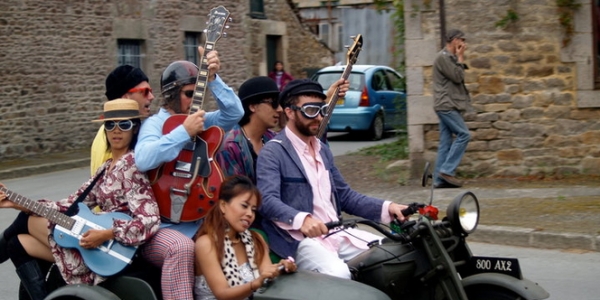What a bizarre mix of concepts. How did the idea to combine male identity with printmaking come about? Meneghetti explains: “It came from a conversation between myself and Joel, from working alongside each other, and during a residency in Western Australia. We’d never collaborated before Performprint. We wanted to make a performance based artwork. We have both become fathers, Joel for the second time, and so we’re thinking about our experiences of life, as men, different models of masculinity, that transition from boy to man. We just keep rolling, keep putting out ideas.” “We’re thinking about gender based issues,” adds Gailer. “This is our conceptual take on being male.”
The exploration of masculinity involves a raft of events, things like a tug of war and use of a cricket pitch roller to make large scale reproductions, culminating in a form of printing very extreme indeed which won’t be revealed here. Endurance is obviously one of the essential aspects of rugged manliness displayed on the day as the performance goes on for ten hours. Audience members can arrive at any time and stay as long as they like. “There are the obvious, pretty clear images of masculinity,” says Meneghetti. “The Harley Davidson rider, the surfer, the skater, the band; there are feats of strength, as well as the durational aspect of it. There is the male imagery of two egos battling it out – those kinds of things are built into the work itself.”
Performprint wouldn’t be a boys’ own adventure without decibels – this aspect comes courtesy of a western Australian rock band (Gentlemen) and a Victorian rock band (MY Band) competing with each other as to who can play loudest.
There are several layers to Performprint, a show which offers massive spectacle informed by some interesting ideas and concepts. To begin with, how is the process of printmaking something which lends itself to live performance?
Joel Gailer explains: “There’s a resurgence of interest in printmaking that’s interesting. I’ve always felt that there’s an aspect of performance to printmaking anyway. It’s a community based thing, there’s rarely just one artist involved in making a print, whether it’s wood blocks or stone plates or pulled prints, even with silk screening. It’s a hard medium to operate in as a solo artist.” Meneghetti agrees. “There’s a performative aspect to printing. If you look at printmaking techniques, there’s a collaborative set of actions, a team of printers working together.”
Making huge prints with giant rollers is an essential part of the performance. “We start off with nothing and throughout the day we fill the Meat Market with paper and ink,” he continues. “We move round the space freely; it’s fairly open, apart from certain things we need to negotiate with other people, bike riders, skaters, bands which happen at set times. There are crescendo points. We’ve laid the structure but it’s open and we build it up throughout the day. We’re going to fill the space. I’m looking forward to seeing how this works. ”
Performprint, according to Gailer, subverts the idea of ‘the original.’ “We don’t subscribe to the idea of the ‘unique original,’” he says. “Performprint is all about copying, reproduction; we talk about masculinity through the realm of the copy, the idea of reproduction.”
“The biggest hurdle is that it’s a really big project,” continues Gailer. “The work involved is quite epic. We don’t have a team; it’s just Michael and I working as visual artists, making all the sculptural props, we’re creating a lot of woodwork, making things with metal, things that neither of us has done before. We produced it in Fremantle in 2012 and it was on a big scale then. The two are also honouring the way the invention of the printing press had such a massive impact on the world. “It was revolutionary,” says Meneghetti. “It opened everything up. Most people’s encounters with famous images are print based. You don’t see the original of the Mona Lisa or the statue of David; you see a reproduction of the image.”
Gailer says the Melbourne show is double the scale of the Fremantle one. “Everything is twice as big, and it was big last time. We’ve doubled the size of everything. We didn’t know what to expect last time and we don’t know what to expect this time. If we fall over or make mistakes we’ll just keep going.” Ah, yes. That stoic male thing.
BY LIZA DEZFOULI

